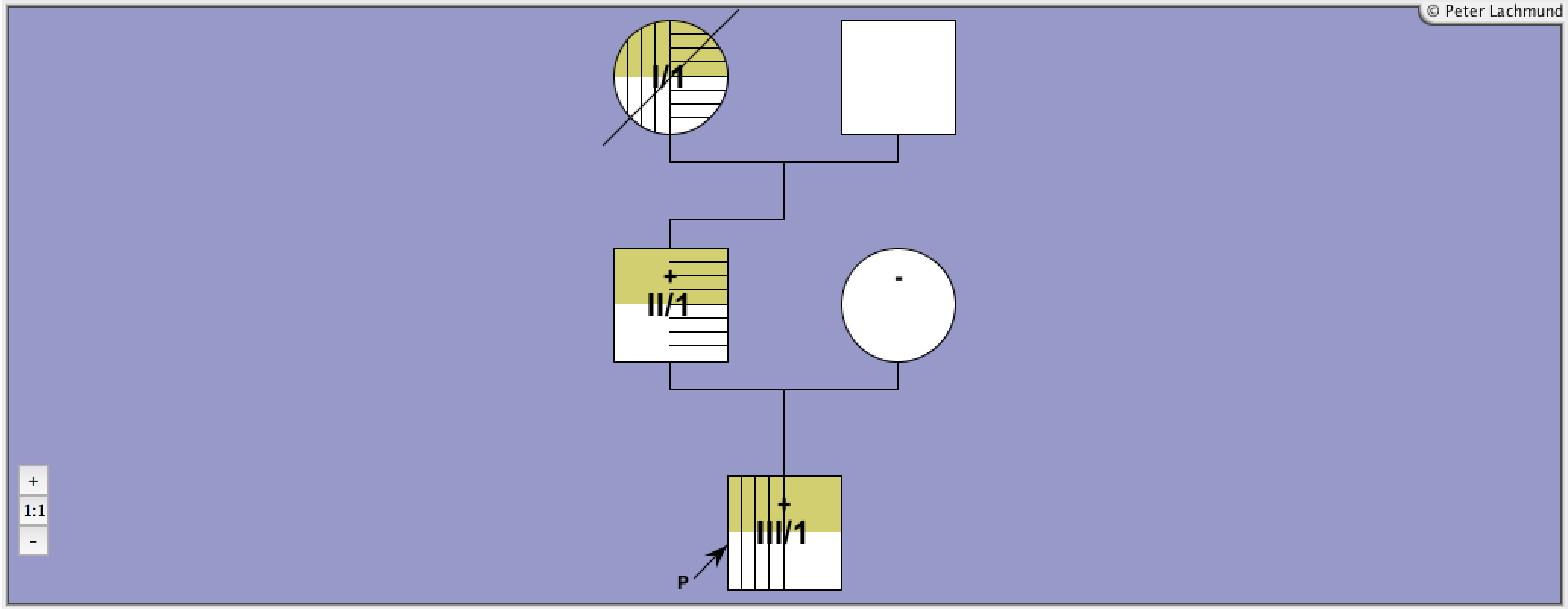Details Of Published TSH Receptor Mutation
Ile 568 Val
c.1702A>GConstitutively Activating TSH Receptor Mutation
Type
gain
Manifestation
family
Exon
10
Legend:

Male

Female

Unknown

Deceased
+
Mutation
-
No Mutation

Hyperthyroidism
(Heterozygous)
(Heterozygous)

Goiter

Relapse
P
Index Patient
Molecular Characteristics:
"Leipzig 2"-family
Clinical Features:
diagnosis:
III/1: 16yr (index patient), goiter
II/1: 18yr
I/1: hyperthyroidism, goiter, deceased
* based on 1 activating germline mutation investigated by Claus et al. 2005
III/1: 16yr (index patient), goiter
II/1: 18yr
I/1: hyperthyroidism, goiter, deceased
* based on 1 activating germline mutation investigated by Claus et al. 2005
Treatment:
III/1: antithyroid drugs ineffective
II/1: subtotal TE at 34yr, relapse of hyperthyroidism at 38yr, radio-iodine therapy
I/1: partial TE at 25yr, three relapses of hyperthyroidism thereafter poorly controlled by further surgery
II/1: subtotal TE at 34yr, relapse of hyperthyroidism at 38yr, radio-iodine therapy
I/1: partial TE at 25yr, three relapses of hyperthyroidism thereafter poorly controlled by further surgery
Functional Characteristics:
cAMP
(basal)
(basal)
cAMP
(TSH)
(TSH)
IP
(basal)
(basal)
IP
(TSH)
(TSH)
TSH-Binding
Cell Surface Expression
Prevalence
LRA
Ref
2.2-2.9
0.8
0.9-1.0
1.1
0.8-1.0
1
1.9+/-0.8;4.4+/-0.1
1-4
Legend:
cAMP (basal): basal in vitro cAMP production of mutant over wild-type TSHR
cAMP (TSH): maximal in vitro cAMP production of mutant over wild-type TSHR
IP (basal): basal in vitro IP production of mutant over wild-type TSHR
IP (TSH): maximal in vitro IP production of mutant over wild-type TSHR
TSH-binding: maximal TSH-binding compared to the wild-type TSHR
Cell surface expression: cell surface expression of mutant compared to WT-TSHR
LRA: linear regression analysis (LRA) of constitutive activity as a function of TSHR expression determined by 125I-bTSH binding or FACS analysis compared to the wild-type TSHR
Prevalence: Prevalence of (somatic and germline) activating mutations*
Ref: Reference for functional characterization
Child: Found in children.
Reference 1:
Claus et al.
Thyroid 15: 1089-94
Novel thyrotropin receptor germline mutation (Ile568Val) in a Saxonian family with hereditary nonautoimmune hyperthyroidism.
2005
Reference 2:
Mueller et al.
Thyroid. 19(7):765-73
Cases of borderline in vitro constitutive thyrotropin receptor activity: how to decide whether a thyrotropin receptor mutation is constitutively active or not?
2009
Reference 3:
Jäschke et al.
Endocrinology 147:1753-1760
An aromatic environment in the vicinity of serine 281 is a structural requirement for thyrotropin receptor function.
2006
Reference 4:
Kleinau et al.
J Biol Chem 282:518-525
Contacts between extracellular loop two and transmembrane helix six determine basal activity of the thyroid-stimulating hormone receptor.
2007

